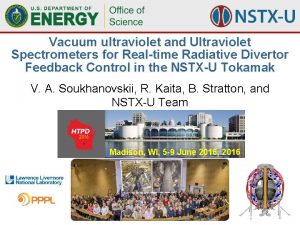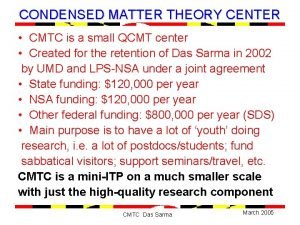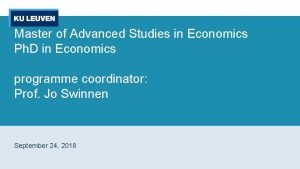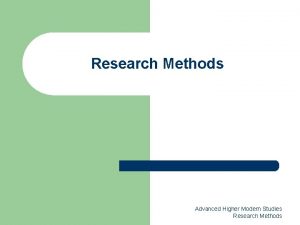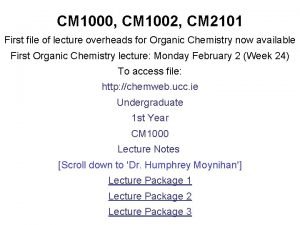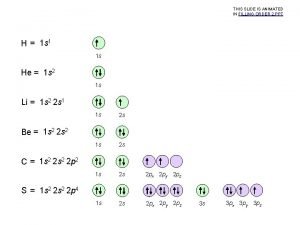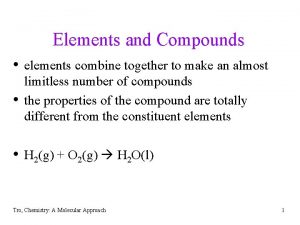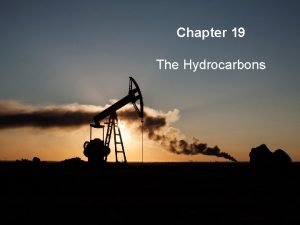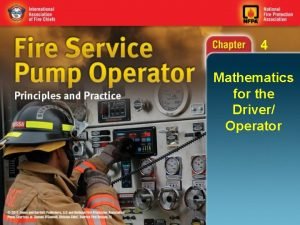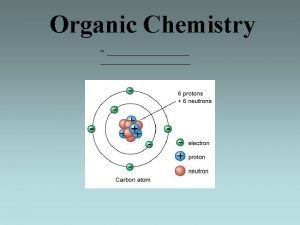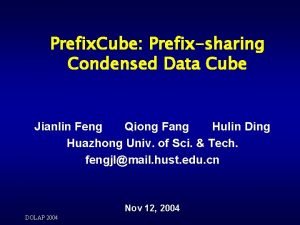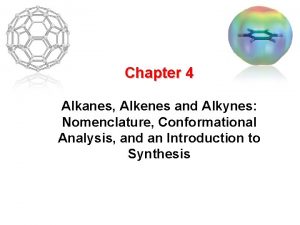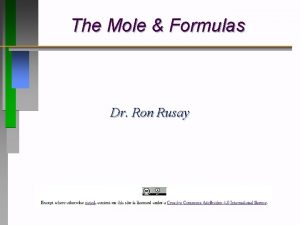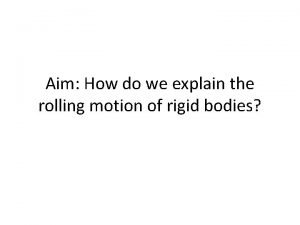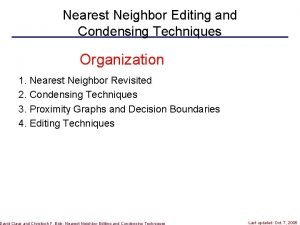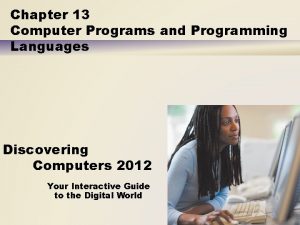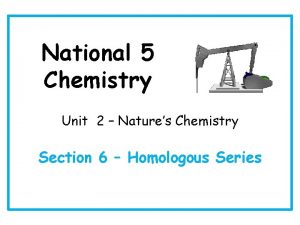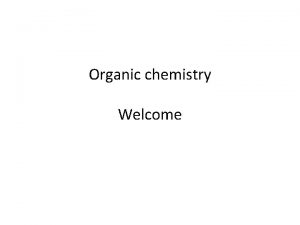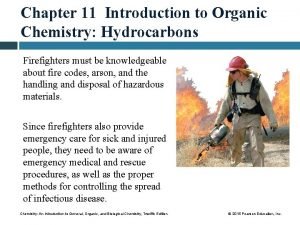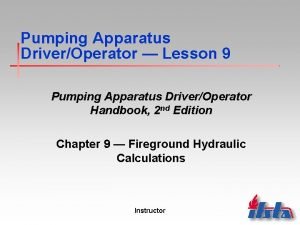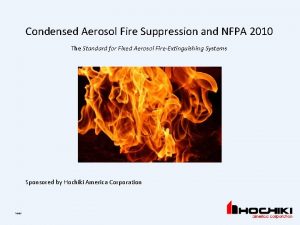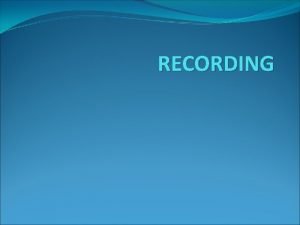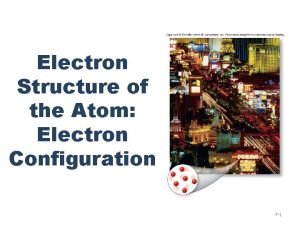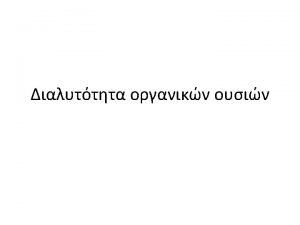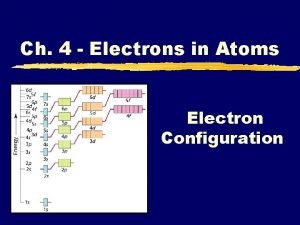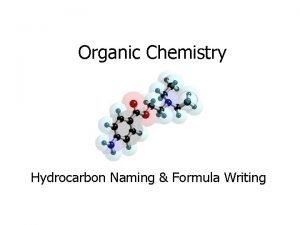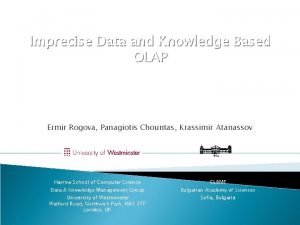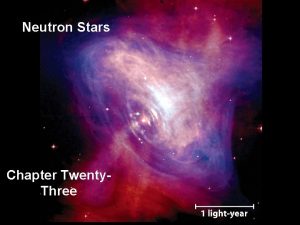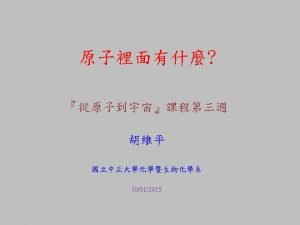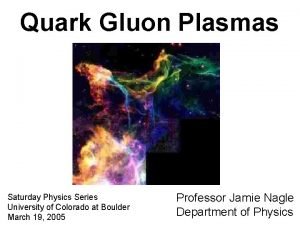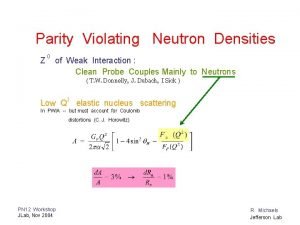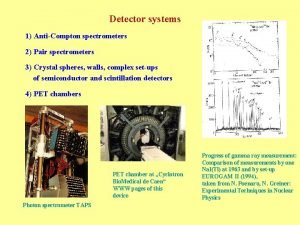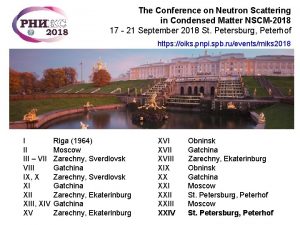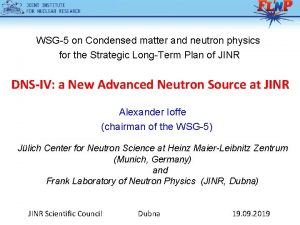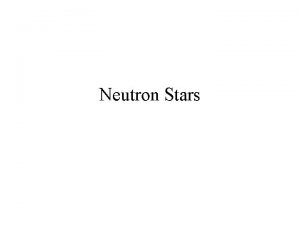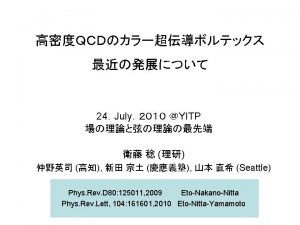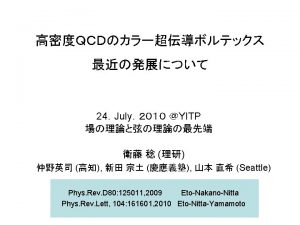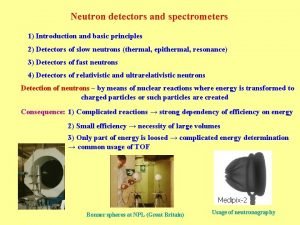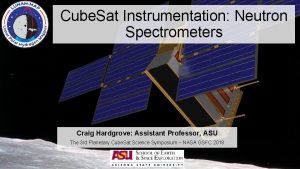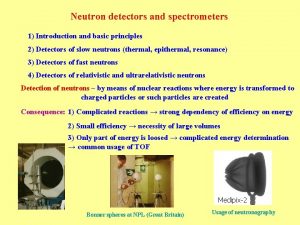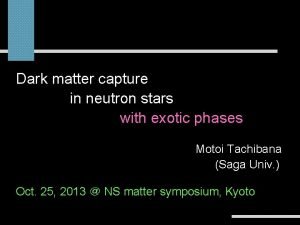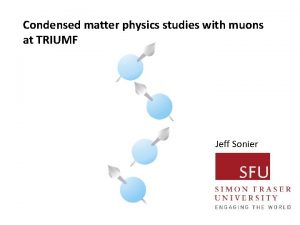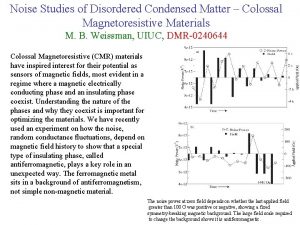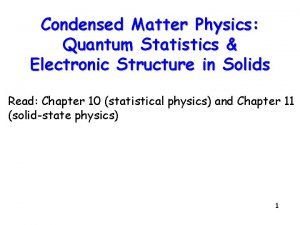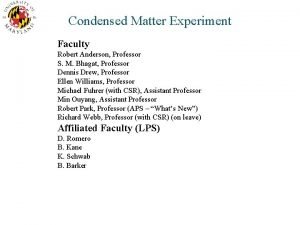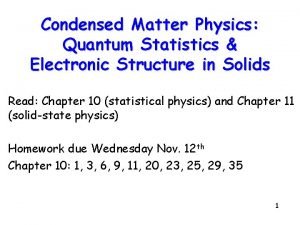Advanced neutron spectrometers for condensed matter studies at










































- Slides: 42

Advanced neutron spectrometers for condensed matter studies at the IBR-2 M reactor Anatoly M. Balagurov Frank Laboratory of Neutron Physics, JINR, Dubna, Russia v Neutron scattering for condensed matter science. v IBR-2 M pulsed reactor as a neutron source of third generation. v Performance of neutron scattering spectrometers at the IBR-2 M. v Perspectives. Hydrogen: primary energy sources, energy converters and applications 1

Neutron space and time domain S(Q, ω) ~ ∫∫ei(Qr – ωt) G(r, t)drdt l ~ 2π/Q, τ ~ 2π/ω For elastic scattering: ΔQ = (10 -3 – 50) Å-1 Δl = (0. 1 – 6· 103) Å Nanostructured materials are inside! Neutron scattering features: - Strong magnetic interaction, - Sensitivity to light atoms, - Sensitivity to isotopes, - Large penetration length, … 2

Success of neutron scattering experiment depends on: I. Parameters of a neutron source average power, pulse width, spectral distribution, . . . II. Performance of a spectrometer intensity, resolution, (Q, E)-range, available sample environment, . . . III. Team at spectrometer head of team, experience, contacts, . . . 3

Neutron sources for condensed matter studies I. Continuous neutron sources II. Pulsed neutron sources W = 10 – 100 MW Const in time VVR-M, Russia IR-8, Russia, ILL, France LLB, France BENSC, Germany FRM II, Germany BNC, Hungary NIST, USA ORNL, USA … SINQ, Switzerland II-a. SPS W = 0. 01 – 1 MW Pulsed in time Δt 0 ≈ (15 – 100) μs ISIS, UK LANSCE, USA SNS, USA KENS, Japan J-SNS, Japan II-b. LPS W = 2 – 5 MW Pulsed in time Δt 0 ≈ (300 – 1000) μs IBR-2 M, Russia ESS, Europe LANSCE (new) ? ? ? 4

TOF high-resolution diffractometer at LPS type source Neutron pulse after fast chopper Δt 0 ≈ (20 – 50) μs Fermi chopper with 2 slit packages 21. 79 m 22. 5 m 23. 5 m 6 Disc choppers 29. 9 m 49. 6 m 73. 4 m Δd/d ≈ 0. 001 for back scattering Magnet (25 T) 5

HRFD – High Resolution Fourier Diffractometer at IBR-2 Put into operation in 1994 in collaboration between: FLNP (Dubna), PNPI (Gatchina), VTT (Espoo), Izf. P (Drezden) 6

HRFD resolution The utmost TOF resolution of HRFD For V=11, 000 rpm & L=30 m Diffraction patterns of Al 2 O 3 measured at ISIS (UK) and IBR-2 (Dubna). Resolution is the same, despite L is 5 times longer at ISIS. Rt=0. 0002 (0. 0009 now) 7

Neutron spectrometers on the IBR-2 M reactor Diffraction (6): HRFD, DN-2, SKAT, EPSILON, FSD, DN-6 SANS (2): Yu. MO, SANS-C Reflectometry (3): REMUR, REFLEX, GRAINS Inelastic scattering (2): NERA, DIN 13 spectrometers (3 new) 8

Spectrometers on existing pulsed neutron sources* Technique Source IBR-2(M) (Russia) ISIS** (UK) IPNS*** LANSCE (USA) KENS (Japan) Diffraction 6 (6) 8 (+2) 4 6 5 SANS 1 (2) 2 (+1) 2 1 1 Reflectometry 2 (3) 2 (+3) 2 2 2 Inelastic Scat. 3 (2) 9 (+1) 3 3 5 Total 12 (13) 21 (+7) 11 12 13 * At a new SNS (Oak Ridge) neutron source 18 spectrometers are planning ** Numbers in brackets – spectrometers at the II Target Station *** IPNS is closed in the very beginning of January 2008 9

Diffraction at the IBR-2 M 1. HRFD* powders – atomic and magnetic structure 2. FSD* bulk samples – internal stresses 3. DN-2 powders – real-time, in situ 4. DN-6 microsamples – high-pressure (new project) 5. EPSILON** rocks – internal stresses 6. SKAT** rocks – textures * Fourier RTOF technique ** Long (~100 m) flight pass 10

Diffraction at the IBR-2 M. Resolution. HRFD FSD DN-2 DN-6 powders internal stresses real-time, multilayers high-pressure EPSILON stresses SCAT textures Resolution becomes better for longer d-spacing! 11

1 2 No 1 1. 2. No 4 4 3. 20 K 4. No 5 300 K Chamber of the cold moderator. Light water premoderator. Flat water reflector. Outer border of the reactor jacket. No 6 water 3 No 9 Combi-moderator at the central direction of the IBR-2 M reactor, plan view 12

Cold moderators at the IBR-2 M reactor Gain factor as a function of λ Diffraction patterns of Tb. Fe. O 3 measured at Tmod=30 K and 300 K Neutron flux distributions as a function of λ 13

HRFD development Actual state Resolution: one of the best in the world Intensity: not high enough (Ωd≈0. 2 sr) Could be Resolution: best among neutron diffractometers Intensity: 10 times better than now 1. Neutron guide 2. Detector array 3. Correlation electronics ~500 KUSD 14

New diffractometer for micro-samples and high-pressure studies Chopper Actual state Neutron guide Sample Ring-shape detectors Resolution: optimal for high-pressure studies Intensity: one of the best in the world Pressure: up to 7 GPa in sapphire anvils Could be Intensity: 25 times better than now Pressure: 20 -30 GPa in natural diamond or mussonite Ring-shape multi-element Zn. S(Ag)/6 Li. F detector 1. Detector array 2. Neutron guide ~250 KUSD 15

GRAINS: complete reflectometry at the IBR-2 M reactor FLNP: M. Avdeev, V. Lauter-Pasyuk V. Aksenov, V. Bodnarchuk Germany: H. Lauter PNPI: V. Trounov, V. Ul’yanov Parameters: Resolution: optimal, δλ/λ = (0. 3 – 7)%, angular = (1 – 10)% Q-range: optimal, (0. 002 – 0. 3) Å– 1 Intensity: one of the best in the world Modes: • Reflectometry in vertical plane, • Off-specular scattering, • GISANS with polarized neutrons. Cost estimate = 1050 k. EUR Contributions: - Germany, Hungary, - Romania, external. 16

A new reflectometer GRAINS at the IBR-2 M reactor Main feature: vertical scattering plane → studies of liquid media 17

Frank Laboratory of Neutron Physics Condensed Matter Department Proposals for IBR-2 M spectrometer complex development program Editors: Victor L. Aksenov, Anatoly M. Balagurov Dubna, 2006 The second edition of the proposals is under preparation. 18

Proposals for 2008 – 2011 Development of existing spectrometers 1. 2. 3. 4. 5. 6. 7. 8. 9. HRFD (SA) FSD (SA) DN-2 SKAT (BMBF) EPSILON (BMBF) Yu. MO REMUR DIN (Ros. Atom) NERA (Poland) 4, 000 K$ New spectrometers 1. 2. 3. 4. 5. 6. DN-6 RTS SANS-C GRAINS SESANS-P 3, 000 K$ General-purpose projects 1. 2. 3. 4. 5. Moderators Detectors Sample environment Cryogenics Electronics 2, 700 K$ In total: 9. 7 M$ for 4 years 19

Priorities for 2008 Priorities for 2009 - 2011 Approved projects Strategical necessity FSD DN-6 Yu. MO / SANS-C Projects with external support SCAT EPSILON GRAINS HRFD Projects without clear perspective REMUR, NERA, DIN, SESANS, SANS -P, DN-2, RTS 20

New science after 2010 1. Modern material science - nanostructures (catalysts, multilayers, porous materials, …), - materials for energy (electrochemistry, hydrogen, …), - biomaterials, polymers (soft-matter), - new constructive materials for atomic energy, - geological problems (earthquakes, waste deposit, …), … 2. Modern fundamental physics - complex magnetic oxides with strong correlations, - low-dimensional magnetism, - phase coexistence in crystals, … 21

User program at the IBR-2 spectrometers International experts’ Time-sharing (13 spectrometers) commissions: I. Diffraction II. Inelastic Scattering FLNP (35%) External fast (10%) External regular (55%) III. Polarized neutrons IV. SANS IBR-2 operational time: ~2000 hours/year Number of experiments: ~150 per year External users: ~100 per year User statistics Others, 19% FLNP, 25% France, 3% Poland, 5% Germany, 17% Russia, 31% 22

Condensed Matter Department at FLNP JINR staff Member States staff 38 28 1999: 52 + 28 = 80 Professor Doctor of science Candidate of science Ph. D. + students 4 10 26 11 2007: 38 + 28 = 66 What staff do we need? CMD administration Heads of directions Group at spectrometer Technical group Additional techniques Scientific groups ~4 4 ~ 3 x 13 = 39 5 ~5 ~ 10 ~ 67 Age distribution There exists a substantial deficiency of permanent staff personnel 23

v IBR-2 is one of the best neutron sources in the world and the only existing advanced neutron source among JINR Member States. v Existing spectrometers are comparable with that at other advanced pulsed neutron sources; some of them are unique. v Experimental potential of the complex is much higher than that existing now. v All spectrometers are accessible for international community in a frame of accepted proposals. v Period 2008 – 2010 is most convenient for global development of neutron spectrometers. v Adequate financial support is urgently needed. 24

Ambitious goal for Condensed Mater Department, Frank Laboratory of Neutron Physics, and Joint Institute for Nuclear Research: Experimental complex based on the IBR-2 M reactor fundamental and applied investigations of advanced and nanostructured materials. 25

From White-Egelstaff law-book for thermal neutron scattering (~1970): Law 2: Neutrons are to be avoided where there is an alternative! New version: Neutrons can be applied everywhere, even if an alternative there exists! For studies of nanostructured materials as well ! 26

Thank you ! 27

Neutron spectrometers on the ISIS spallation source (RAL, UK) Diffraction (8): GEM, HRPD, PEARL, POLARIS, ROTAX, SXD, ENGIN-X, INES SANS (2): SANDALS, LOQ Reflectometry (2): CRISP, SURF Inelastic scattering (9): HET, MAPS, MARI, MERLIN, PRISMA, IRIS, OSIRIS, TOSCA, VESUVIO 21 spectrometers 28

from MEETING REPORT “Consultancy on the Status of Pulse Reactors and Critical Assemblies” IAEA, 16 – 18 January 2008 The IBR-2 reactor at Joint Institute on Nuclear Research, Dubna is a unique facility internationally, and is being refurbished/modernized to continue to serve as an international centre of excellence for neutron sciences. 29

Diffraction at the IBR-2 M. Intensity. Mo powder measured in 1 min (1) and 0. 2 sec (2). Intensity / Counting rate I ≈ Φ 0 · S · Ω/4π · δ [n/s] ≥ 106 n/s Φ 0 – neutron flux at a sample, 107 n/cm 2/s S – sample area, 5 cm 2 Ω – detector solid angle, 0. 2 sr δ – scattering probability, 0. 1 30

IBR-2 M pulsed reactor (with cold moderators) is the source of third generation*) Source Parameter SNS, USA (SPS) JSNS, Japan (SPS) IBR-2 M, JINR (LPS) ESS, Europe (LPS) Status 2008 2009 2010 2015 ? 1200 1000 2000 5000 15 - 100 15 – 100 350 1000 ? 60 25 5 >20 Power, k. W Pulse width, μs Frequency, s-1 *) For 2 nd generation sources W is between 6 – 200 k. W (IPNS, KENS, LANSCE, ISIS) 31

Resources which are needed to complete the 2007 - 2010 program Technical needs: 1. Neutron guides – 2. 1 D PSD – 3. 2 D PSD – Financial needs (in KUSD): ~ 300 m 5 4 A. Development (9) – 4, 105 (456) B. New projects (6) – 2, 991 (499) Total (15): 7, 096 4. Large aperture det-s – 6 5. Choppers – 6 6. Neutron optics devices 7. Spin analyzers & polarizers 8. Electronics & computing 9. Sample environment: refrigerators, thermostats, magnets, acoustic technique… 32

Hydrogen materials: what can we learn with neutrons? Location of H, OH, H 2 O in crystal: Dynamics of H, OH in crystal: Diffusion of H, H 2 O in solids or liquids: Clustering of H, nanostructures: coherent elastic, diffraction. incoherent inelastic. quasielastic incoherent elastic, SANS. Exchange membrane, hydration/dehydration: diffraction, reflectometry. Quantitative analysis: incoherent scattering / absorption. H (and Li) are the most important Elements for fuel cells and batteries! Proton exchange membrane 33

Phase transformations of high pressure heavy ice VIII. Time-resolved experiment with t = (1 – 5) min. Ih Ice VIII Ic Tim e& tem hda per atu re s cal e le TOF sca Time / temperature scale: Tstart=94 K, Tend=275 K. The heating rate is ≈1 deg/min. Diffraction patterns have been measured each 5 min. Phase VIII is transformed into high density amorphous phase hda, then into cubic phase Ic, and then into hexagonal ice Ih. 34

Project EPSILON/SKAT: Investigation of strain/stress and texture on geological samples Spokesman from JINR: Spokesman from Germany: Dr. Ch. Scheffzük Dr. habil. A. Frischbutter EPSILON-MDS SKAT New neutron guide Could be Intensity: 10 times better than now ~106 EUR 35

Diffraction at the IBR-2 M. General conclusion. Unique complex with world top opportunities in: - extremely high-resolution (HRFD), - extremely high-intensity (DN-6, DN-2), - applied studies (FSD, EPSILON, SKAT). 36

Polarized neutron scattering at the IBR-2 M 1. REMUR magnetic multilayers – magnetic structures 2. GRAINS interface science in physics, biology, chemistry (new project) 3. REFLEX reflectometry in horizontal plane, now is used in test mode 37

Resolution at pulse neutron source. Elastic scattering. R = [(Δt 0/t)2 + (Δ /tg )2]1/2 For Δt 0 ≈ 350 μs, L ≈ 25 m, λ ≈ 4 Å TOF contribution is ~1%. Geometrical contribution is: ~(0. 05 – 0. 2)% for back scattering ~(5 – 10)% for SANS and reflectometry TOF component in resolution function is not important for: SANS and Reflectometry It is not very important for: single crystal diffraction, magnetic diffraction… Powder diffraction: structural studies, stress analysis, low symmetry textures? 38

Criteria which could be used for the evaluation 1. Modern and interesting science. 2. Correspondence to the IBR-2 M features. 3. Top level parameters. 4. Active and effective team. 5. External support (financial, technical, …). 39

Proposals at the IBR-2 reactor, JINR, Dubna IBR-2 operational time: ~2000 hours/year Number of experiments: ~150 per year External users: ~100 per year 40

Research reactors in the JINR Member States Russia Czechia I. Dubna, IBR-2 (1984, 2 MW, pulsed) I. Řeź, LVR-15 (1970, 10 MW) II. “RCC KI” Moscow, IR-8 (1957, 8 MW) Germany III. Gatchina, VVR-M (1959, 16 MW) I. Munich, FRM-II (2005, 20 MW) IV. Yekaterinburg, IVV-2 M (1966, 15 MW) II. Berlin, BENSC (1973, 10 MW) V. Obninsk, VVR-M (1960, 12 MW) Hungary I. Budapest, BNC (1970, 10 MW) The enhanced flux and new instrument concepts will allow to improve the resolution in both space and time ==> “new science”! 41

Neutron Techniques (developed at the IBR-2) DINS LND NBS ND NHol NI NPol NRad NRef NTom NSE Pol. N PST QENS SANS TAS TOF USANS ZFNSE Deep Inelastic Neutron Scattering Laue Neutron Diffraction Neutron Back-Scattering Neutron Diffraction Neutron Holography Neutron Interferometry Neutron Polarimetry Neutron Radiography Neutron Reflectometry Neutron Tomography Neutron Spin-Echo Polarized Neutrons Phase-Space Transformation Quasi-Elastic Neutron Scattering Small Angle Neutron Scattering Triple-Axis Spectrometry Time-Of-Flight (techniques) Ultra SANS Zero-Field NSE At the IBR-2 the techniques are developed, which are the most effective for condensed matter studies and above all for studies of nanostructured materials. 42
 Vacuum uv spectrometers
Vacuum uv spectrometers Umd cmtc
Umd cmtc Advanced certificate management studies
Advanced certificate management studies Higher modern studies essay introduction examples
Higher modern studies essay introduction examples Mase ku leuven
Mase ku leuven Advanced higher modern studies research methods
Advanced higher modern studies research methods Paradigm shift from women studies to gender studies
Paradigm shift from women studies to gender studies Function of grey matter and white matter
Function of grey matter and white matter Composition of matter section 1
Composition of matter section 1 Section 1 composition of matter
Section 1 composition of matter Gray matter and white matter
Gray matter and white matter Chapter 2 section 1 classifying matter answer key
Chapter 2 section 1 classifying matter answer key Energy naturally flows from warmer matter to cooler matter
Energy naturally flows from warmer matter to cooler matter Pallium telencephalon
Pallium telencephalon Section 1 composition of matter
Section 1 composition of matter Brain falx
Brain falx Condensed structural formula octane
Condensed structural formula octane Orbital diagram for uranium
Orbital diagram for uranium Combustion analysis
Combustion analysis Carbon compound family
Carbon compound family Condensed q method friction loss
Condensed q method friction loss What are the first 10 alkynes
What are the first 10 alkynes Example of condensed data
Example of condensed data Alkyne condensed formula
Alkyne condensed formula Condensed structural formula of formaldehyde
Condensed structural formula of formaldehyde A metal can containing condensed mushroom soup
A metal can containing condensed mushroom soup Condensed nearest neighbor
Condensed nearest neighbor It uses a condensed form of english to convey program logic
It uses a condensed form of english to convey program logic Alkane molecular formula
Alkane molecular formula Condensed structure of cyclohexane
Condensed structure of cyclohexane Oil rig explosion
Oil rig explosion Relay pumping calculations
Relay pumping calculations Nfpa
Nfpa Verbatim recording in social case work
Verbatim recording in social case work Valence electrons how to determine
Valence electrons how to determine Is sucrose soluble in water
Is sucrose soluble in water Condensed electron configuration of calcium
Condensed electron configuration of calcium Organic chemistry
Organic chemistry Ermir rogova
Ermir rogova Neutron star
Neutron star Proton neutron quarks
Proton neutron quarks Proton neutron quarks
Proton neutron quarks Parity of neutron
Parity of neutron
